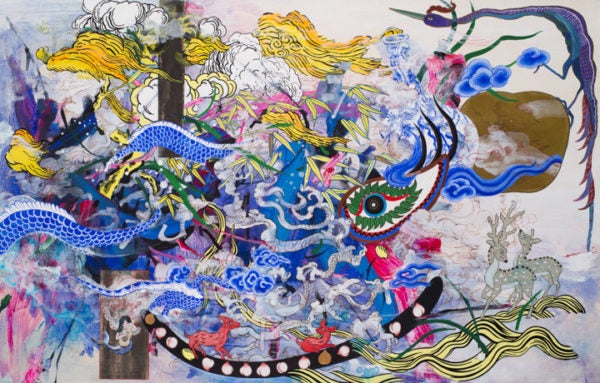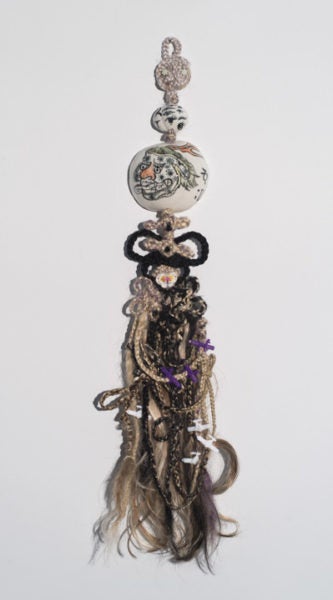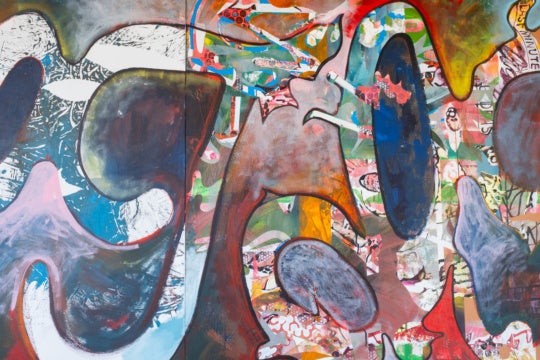
Jiha Moon‘s style has been described as maximalist and culturally engaged. She mines trans-Pacific popular culture and Asian art history to assemble postmodern mashups and awkwardly conjoined paradigms. The exhibition “Double Welcome: Most Everyone’s Mad Here” at the Jule Collins Smith Museum at Auburn University features 65 recent works by the Atlanta-based painter and mixed-media artist.
Moon is attuned to the chaos of globalism’s collapsing boundaries and the resulting homogenization of “stuff.” Her work consists of liquid media applied to a diverse array of substrates, such as stoneware, traditional Hanji paper, and textiles. Moon is a prolific artist, and the viewer can sense her pace from the frantic jostling and crowding of imagery in her compositions. She compulsively adorns and populates spaces in these frenetic works. Dense activity and strong, saturated colors are continuous throughout.

As consumers, we express ourselves by purchasing manufactured goods, many of which are plastic, or bright, or disposable, or all of the above. Moon compiles painted elements in a manner that mimics the consumer’s acquisition of things, employing a language of excess, flat color and hard-edged shapes. Pattern, text and image are all fair game. Her painted spaces emphasize verticality rather than classical depth, climbing upward in front of us like the hills and mountains in traditional Chinese silk painting.
Moon is also interested in the American notion of “Asian-ness,” which she depicts as drifting information that has been altered through commerce. The first room of the exhibition features nineteen small hanging sculptures made of ceramic and synthetic hair. These are derived from traditional Korean charms known as norigae, which feature decorative knots and tassels with gems or pieces of metalwork tied into them. But Moon’s norigae are larger, stranger versions of these charms, their ornate knots made with strands of synthetic hair. Instead of jewels or gems she inserts her own ceramic objects, adorned with text and images that mix Korean tradition with American pop culture.

Pied de Grue is a prime example of Moon’s chaotic gamesmanship. The painting is made of separate pieces of Hanji, a Korean mulberry paper, which have been cut into the shapes of traditional Korean fans. Affixed to each other in a cluster, they are covered with a complex tapestry of plants, patterns, vapors, cranes, birds, logos, and many other elements. Pied de Grue is French for “crane’s foot” and was corrupted to form the English word “pedigree.” The work’s connection to the title is the form it takes: a chart of lineage, splitting from one line into many, just as the bird’s narrow leg splits into its splayed toes. This sort of intricate linguistic play is exactly what is operating in Moon’s imagery. Meanings are transposed and hybridized to form strange taxonomies. This kind of language corruption, based on loose associations and transpositions, is a central operation in Moon’s processing of visual information.

Moon’s graphic painting style is relevant to the language of branding, trademarks and logos. Her saturated acrylic colors are akin to the palettes of vinyl ink that are screen-printed onto T-shirts, or the brand name that has been emblazoned onto disposable coffee cups. Even the expressionistic brush strokes that weave playfully through pieces like Gak-Sul-Yi, which includes only two or three colors. This is the palette of a printer mixing spot color in a shop rather than an expressionist painter with stained clothing and a large encrusted palette. This graphic approach allows her to treat all information as branding that becomes altered as it permeates cultural membranes. So, the traditional crane wandering through the painted Hanji paper in Pied de Grue is accompanied by a flock of floating Twitter birds. Moon’s playfulness and witticisms become the catalyst for her own cheerful corruptions, which simulate a larger cross-cultural phenomena.

Beauty is part of the play in Moon’s work, along with the pleasure of color, material, and humor interacting with one another. She co-opts the language of branding through the use of appropriation and hard-edged imagery, but stops short of overturning any established order. She gives us a space for beautiful strangeness within a landscape of commoditization. The exhibition title, which quotes the Cheshire Cat from Disney’s adaptation of Alice in Wonderland, likens our experiences as consumers to Alice’s baffling encounters. Most everyone may be mad in Moon’s world, but at least we can still have a good time.
“Double Welcome: Most Everyone’s Mad Here,” is on view at the Jule Collins Smith Museum at Auburn University through April 30. It is the fourth stop in an itinerary that included the Taubman Museum in Virginia, the Halsey Institute of Contemporary Art in Charleston, and the Kalamazoo Institute of Contemporary Art.
Orion Wertz is a painter and graphic novelist living in Columbus, Georgia, where he teaches drawing and painting at Columbus State University.




